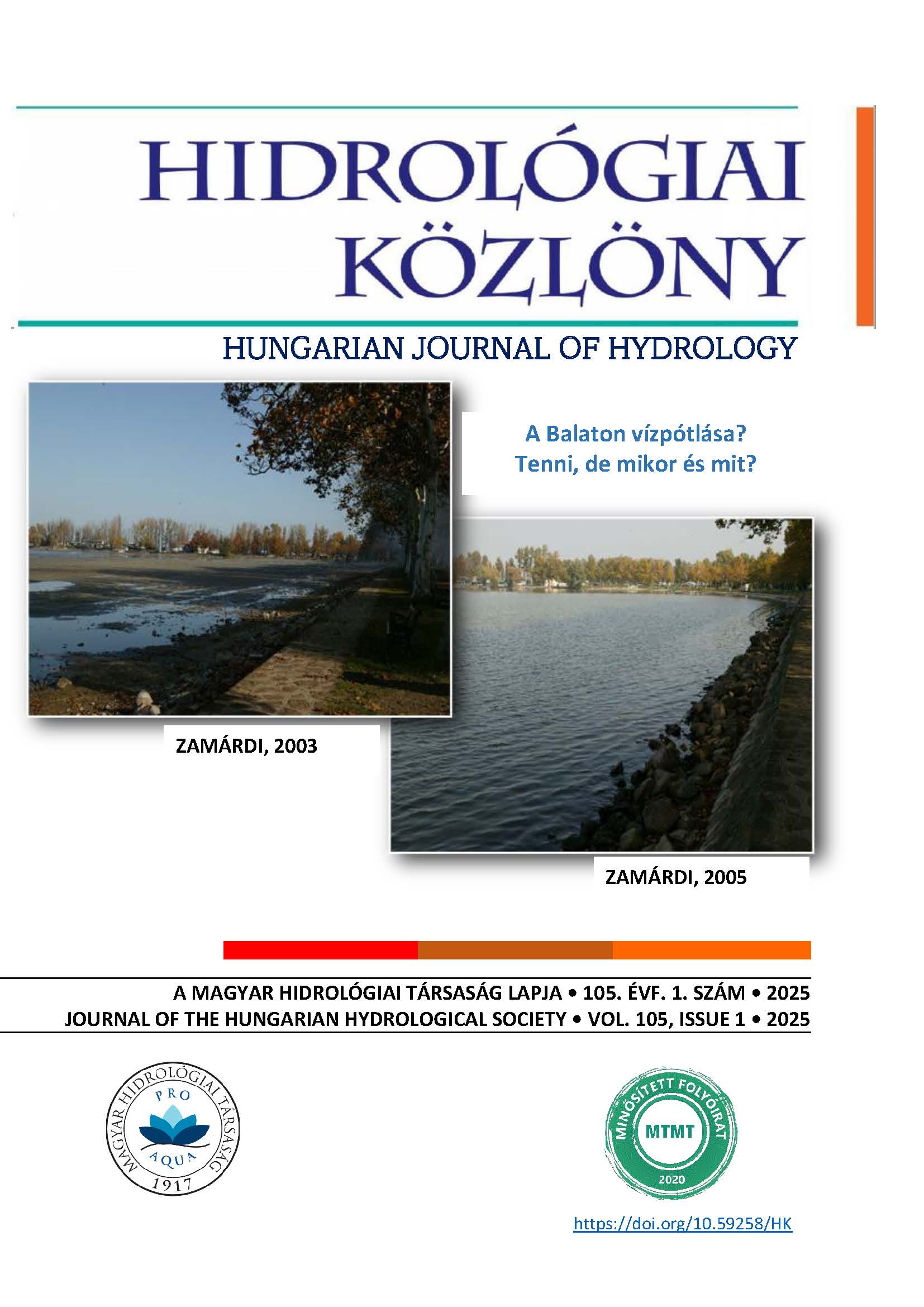Az ANFIS mesterséges neurális hálózat lehetséges bemeneti adatainak vizsgálata csapadék-lefolyás modellezés esetén
Abstract
Artificial neural networks (ANNs) are gaining popularity across various scientific fields. Thus, studies to analyze the applicability of ANNs have also been appearing within the field of hydrology. In the case of rainfall-runoff modeling, one of the most promising networks is the Adaptive Neuro-Fuzzy Inference System (ANFIS), which effectively combines the learning capability of neural networks and the flexible structure of fuzzy systems. ANFIS can model nonlinear phenomena and identify nonlinear components using, for example, the currently applied Takagi-Sugeno type system. In this study, nine-nine ANFIS-based rainfall-runoff models with different input datasets were compared for the catchments of Torna- and Arany-creek. The models were built using the MATLAB software and the "anfis" function. The input datasets included precipitation, antecedent discharge, antecedent precipitation index, temperature, and potential evaporation. The preprocessing of the data included the examinations of quality and standardization. The models can be divided into two groups: six-six models included antecedent discharge as an input, while three-three models did not use the antecedent discharge data. The sensitivity analysis of the models revealed that an optimal number of initial FIS was 2, and 500 training epochs were sufficient. Based on the results from the nine-nine models, ANFIS-based rainfall-runoff models demonstrated adequate model efficiency during calibration, but their performance decreased during validation. Whether the models used the discharge time-series as an input or not, the best-performing models were those that included all the examined input datasets. However, some models produced outlier values at certain time steps, which could be a result of the computational methods or the structure of the neural network.
References
AGROTOPO (2019). https://www.mta-taki.hu/hu/osztalyok/kornyezetinformatikai-osztaly/agrotopo (Letöltve: 2019.10.25.)
Ang, Y., Talei, A., Zahidi, I., Rashidi, A. (2023). Past, Present, and Future of Using Neuro-Fuzzy Systems for Hydrological Modeling and Forecasting. Hydrology. 10. 36. https://doi.org/10.3390/hydrology10020036
Bartoletti, N., Casagli, F., Marsili-Libelli, S., Nardi, A., Palandri, L. (2017). Data-driven rainfall/runoff modelling based on a neuro-fuzzy inference system. Environmental Modelling & Software. https://doi.org/10.1016/j.envsoft.2017.11.026
Chang, T.K., Talei, A., Alaghmand, S., Ooi, M. (2016). Choice of Rainfall Inputs for Event-based Rainfall-Runoff Modeling in a Catchment with Multiple Rainfall Stations Using Data-driven Techniques. Journal of Hydrology. 545. https://doi.org/10.1016/j.jhydrol.2016.12.024
Chang, T.K., Talei, A., Chua, L., Alaghmand, S. (2018). The Impact of Training Data Sequence on the Performance of Neuro-Fuzzy Rainfall-Runoff Models with Online Learning. Water. 11. 52. https://doi.org/10.3390/w11010052
C3S (2019). Copernicus Climate Change Service ERA5-Land reanalysis. Copernicus Climate Change Service, 15/09/2019. https://cds.climate.copernicus.eu/cdsapp#!/home (Letöltve: 2019.09.18.)
CORINE (2019). Land Cover-Copernicus https://land.copernicus.eu/pan-european/corine-land-cover (Letöltve: 2019.10.25.)
Fülöp, I., Józsa, J. (1998). A neurális hálózatok világa. Hidrológiai Közlöny, 78. évfolyam, 4. szám, p. 250.
Jackson, E., Roberts, W., Nelsen, B., Williams, G., Nelson, E., Ames, D. (2019). Introductory overview: Error metrics for hydrologic modelling – A review of common practices and an open source library to facilitate use and adoption. Environmental Modelling & Software. 119. https://doi.org/10.1016/j.envsoft.2019.05.001
Kohler, M.A., Linsley, R.K. (1951). Predicting the runoff from storm rainfall. Weather Bureu Research Papers. Washington.
Kontur, I., Koris, K., Winter, J. (2003). Hidrológiai számítások Lanograf Kft., Gödöllő.
Liptay, Z. (2022). Neurohydrological prediction of water temperature and runoff time series. Acta Hydrologica Slovaca. 23. pp. 190-196. https://doi.org/10.31577/ahs-2022-0023.02.0021.
MATLAB (2024). MATLAB Documentation – anfis. https://www.mathworks.com/help/fuzzy/anfis.html
ODP (2023). Meteorológiai Adattár https://odp.met.hu/ (Letöltve: 2023.09.25.)
Nash, J.E., Sutcliffe, J.V. (1970). River flow forecasting through conceptual models. Part I – A discussion of principles. Journal of Hydrology 10, 282–290. https://doi.org/10.1016/0022-1694(70)90255-6
Nayak, P.C., Sudheer, K.P., Rangan, D.M., Ramasastri, K.S., (2004). A neuro-fuzzy computing technique for modeling hydrological time series. J. Hydrol. 291 (1– 2), pp. 52–66. https://doi.org/10.1016/j.jhydrol.2003.12.010
Pushpalatha, R., Perrin, C., le Moine, N. Andréassian, V. (2012). A review of efficiency criteria suitable for evaluating low-flow simulations. Journal of Hydrology. 420-421, 171-182. https://doi.org/10.1016/j.jhydrol.2011.11.055
Rathnayake, N., Rathnayake, U., Chathuranika, I., Dang, L., Hoshino, Y. (2023). Cascaded-ANFIS to simulate nonlinear rainfall-runoff relationship. Applied Soft Computing. 147. https://doi.org/10.1016/j.asoc.2023.110722
Talei, A., Chua, L. (2012). Influence of lag time on event-based rainfall–runoff modeling using the data driven approach. Journal of Hydrology. s 438–439. pp. 223–233. https://doi.org/10.1016/j.jhydrol.2012.03.027
Talei, A., Chua, L., Quek, C. (2010). A novel application of a neuro-fuzzy computational technique in event-based rainfall–runoff modeling. Expert Systems with Applications. 37. pp. 7456-7468. https://doi.org/10.1016/j.eswa.2010.04.015
Talei, A., Chua, L., Quek, C., Jansson, P. (2013). Runoff forecasting using a Takagi–Sugeno neuro-fuzzy model with online learning. Journal of Hydrology. 488. 17–32. https://doi.org/10.1016/j.jhydrol.2013.02.022
Tayfur, G., Singh, V., Asce, F. (2006). ANN and Fuzzy Logic Models for Simulating Event-Based Rainfall-Runoff. Journal of Hydraulic Engineering. https://doi.org/10.1061/(ASCE)0733-9429(2006)132:12(1321)
Van Ooyen, A., Nienhuis, B. (1992). Improving the convergence of the backpropagation algorithm. Neural Networks 5 (3), pp. 465–471. https://doi.org/10.1016/0893-6080(92)90008-7
Wang, W., Chau, K., Cheng, C., Qiu, L. (2009). A Comparison of Performance of Several Artificial Intelligence Methods for Forecasting Monthly Discharge Time Series. Journal of Hydrology. 374. pp. 294-306. https://doi.org/10.1016/j.jhydrol.2009.06.019
Copyright (c) 2025 Klaudia Négyesi, Eszter Dóra Nagy

This work is licensed under a Creative Commons Attribution-NonCommercial-ShareAlike 4.0 International License.




